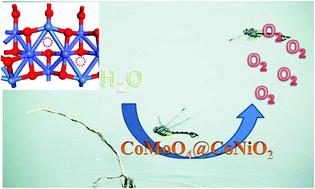Oxygen vacancy-confined CoMoO4@CoNiO2 nanorod arrays for oxygen evolution with improved performance†
Abstract
A typical hydrothermal preparation approach has been exploited for the first time to grow CoMoO4@CoNiO2 nanostructures in situ on a Ni foam support. The turnover frequency (TOF), to our knowledge, is also among the highest values reported so far for supported catalysts for electrocatalytic water oxidation. The effect of oxygen vacancy density on the electrocatalytic performance was further investigated via employing X-ray photoelectron spectroscopy characterization. The DFT calculation results show that the presence of oxygen vacancies increases the adsorption energy of the reactants and modulates the electronic structure of the surrounding atoms, thus increasing the electrocatalytic performance.



 Please wait while we load your content...
Please wait while we load your content...